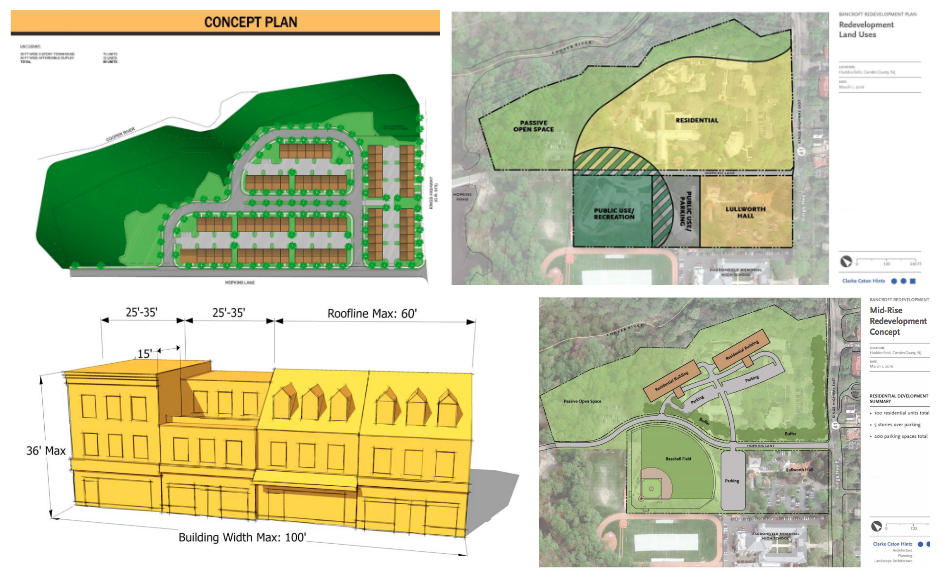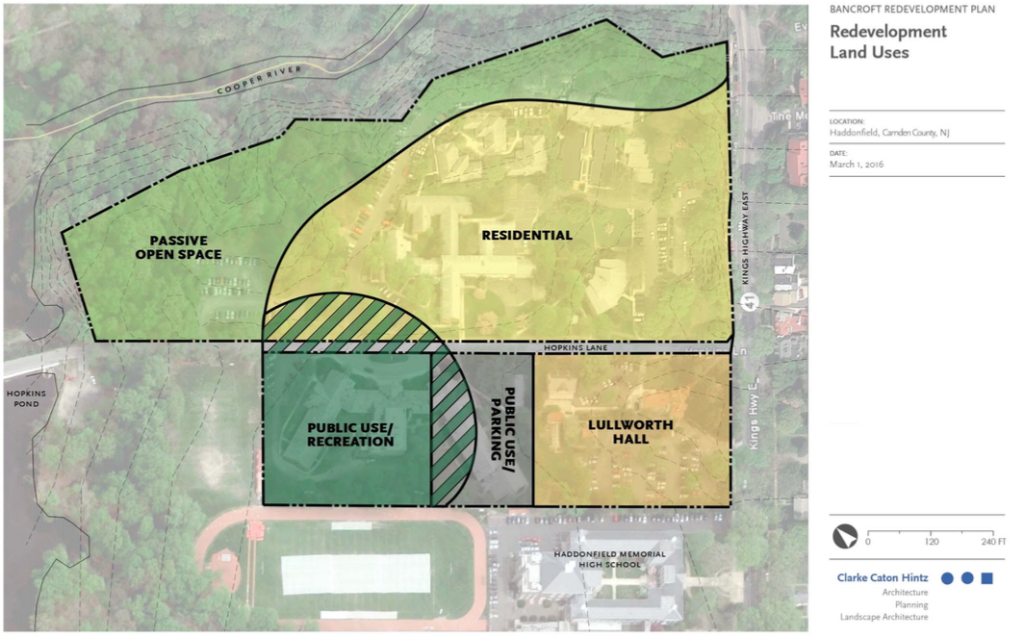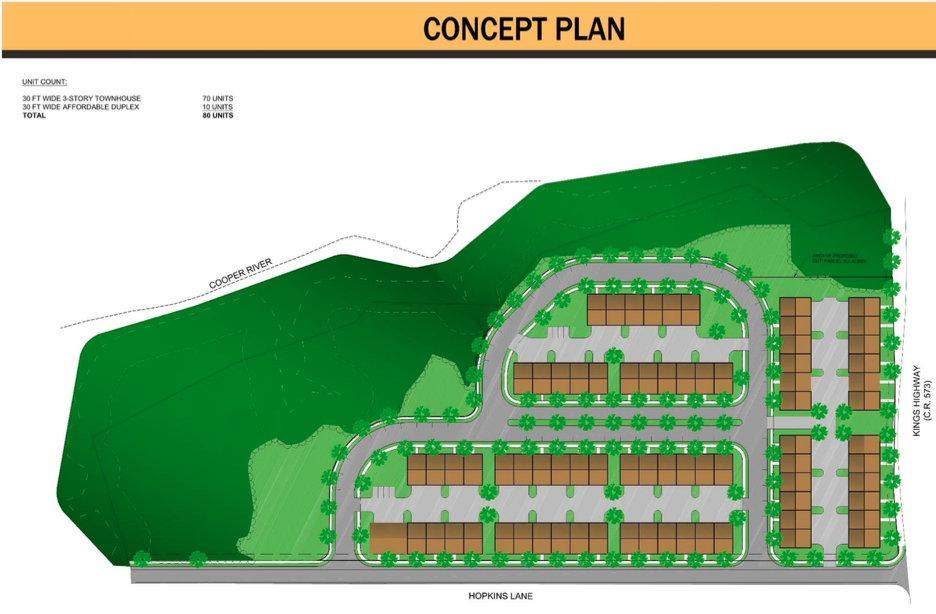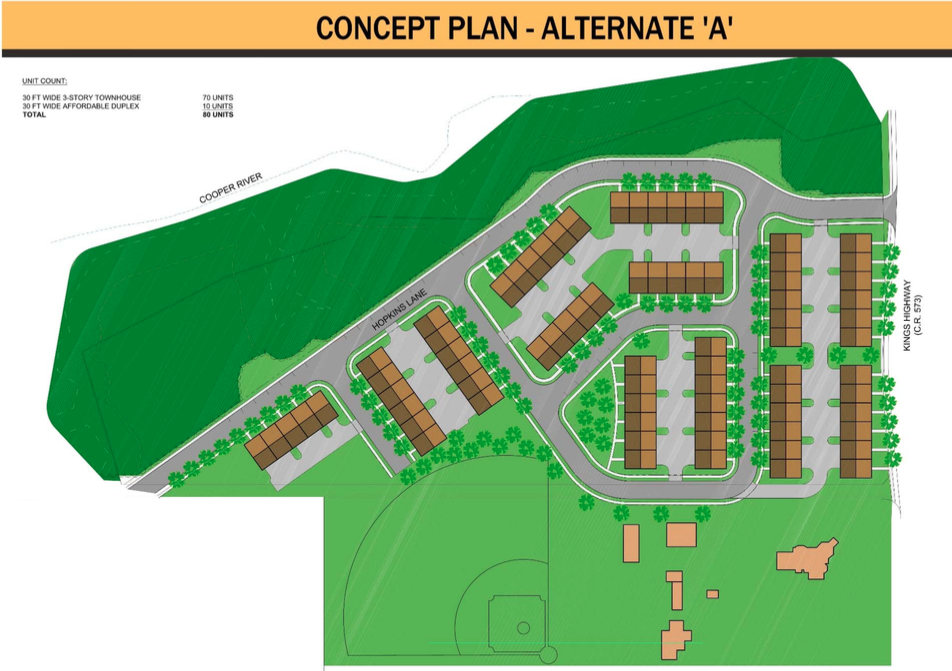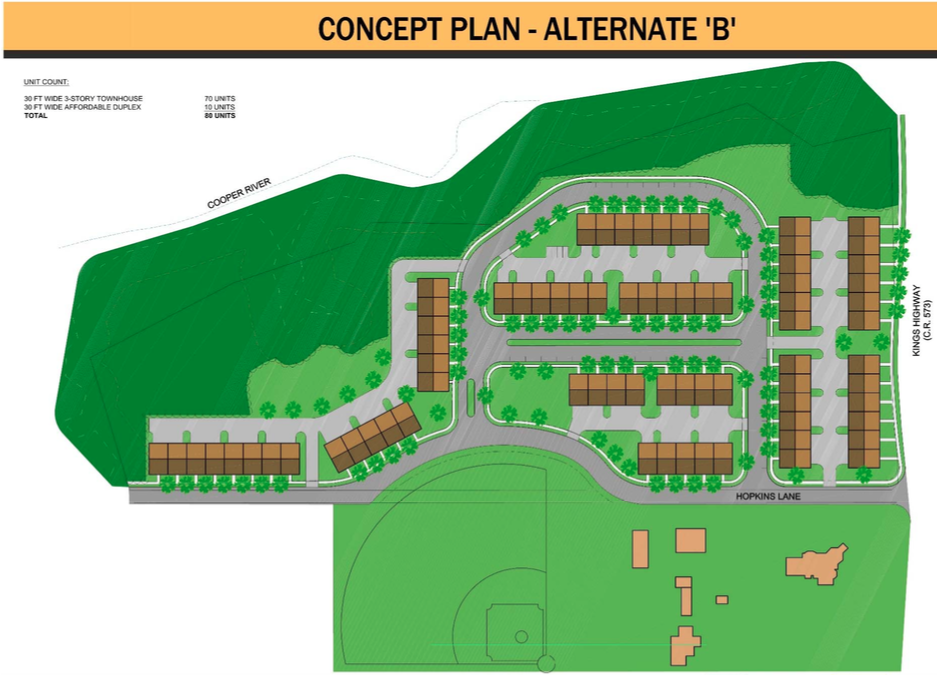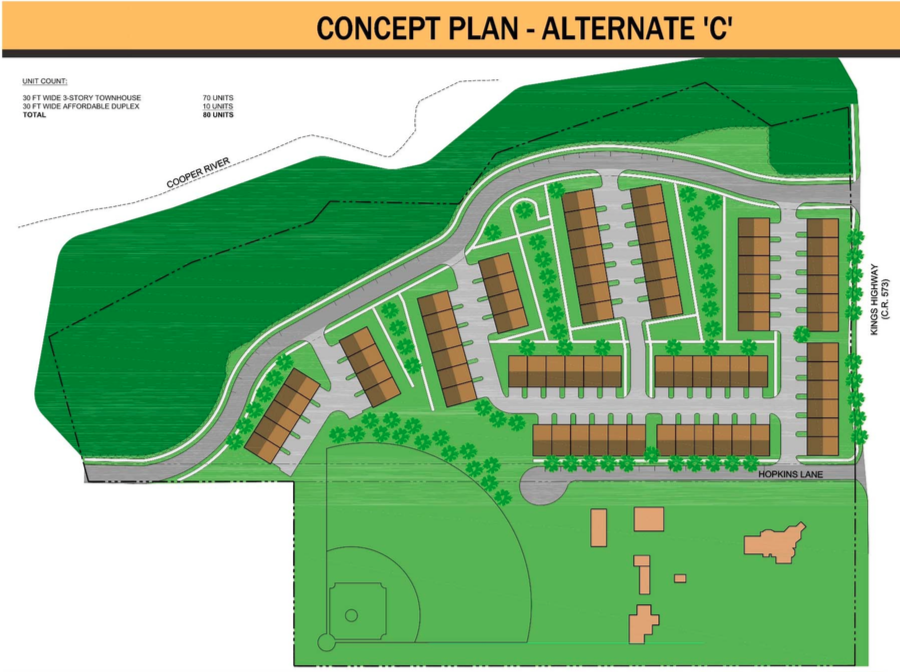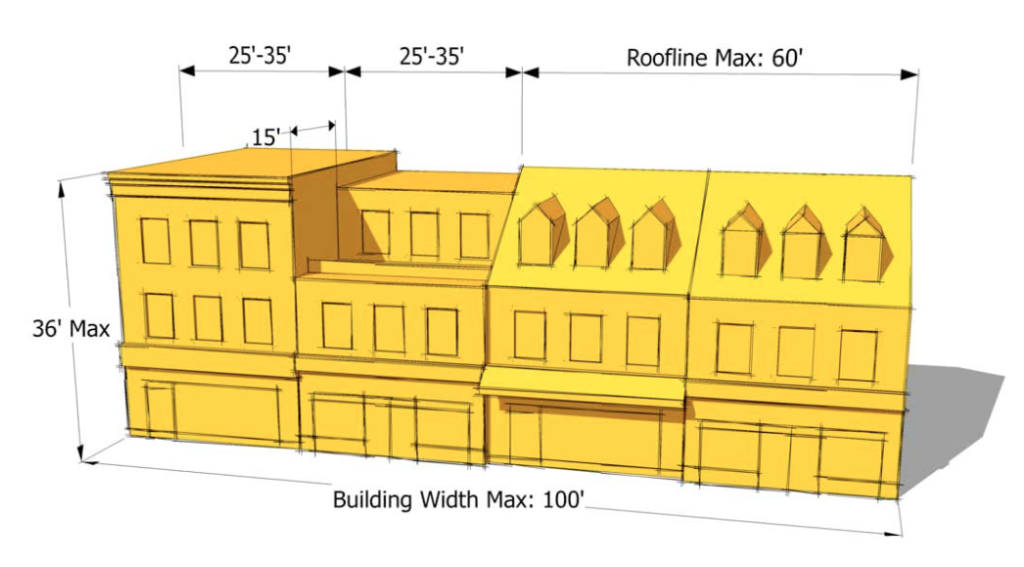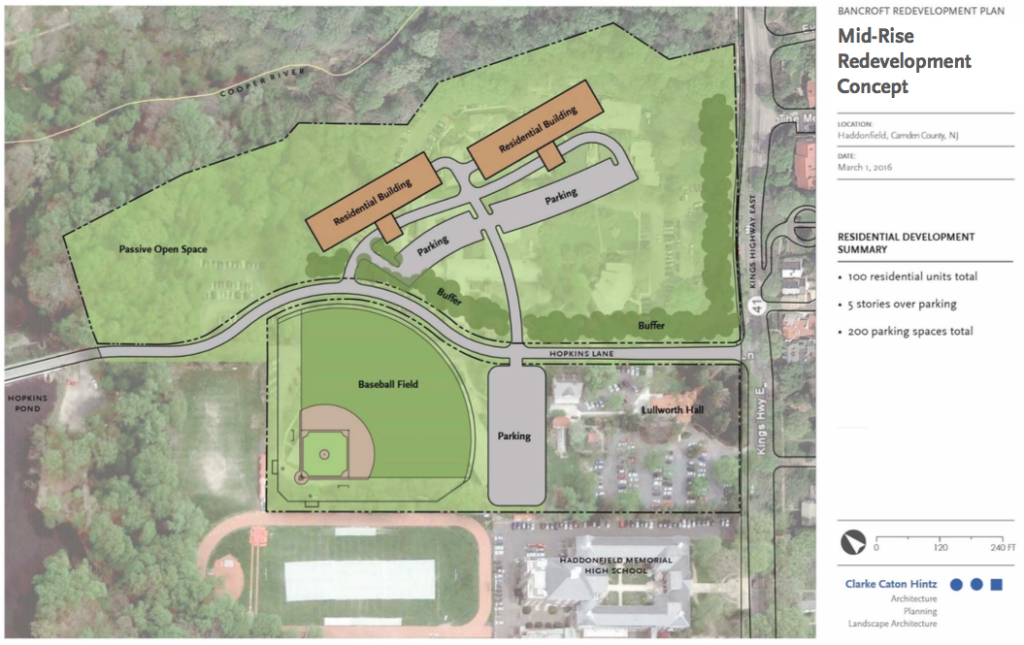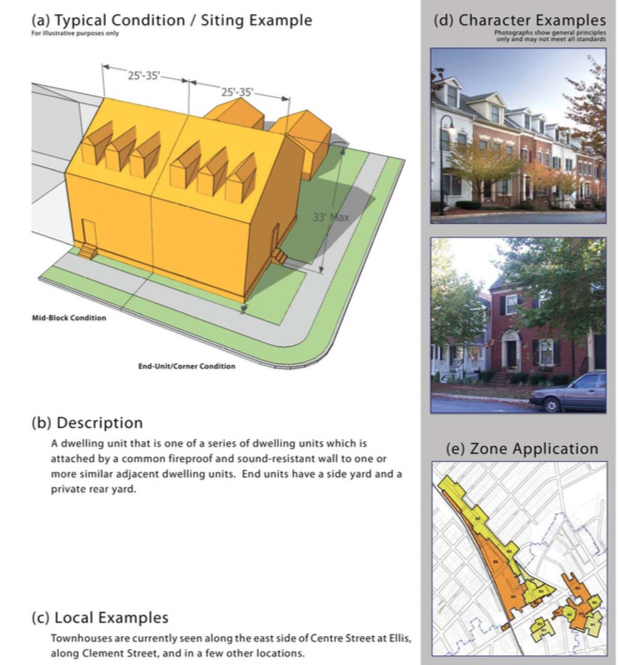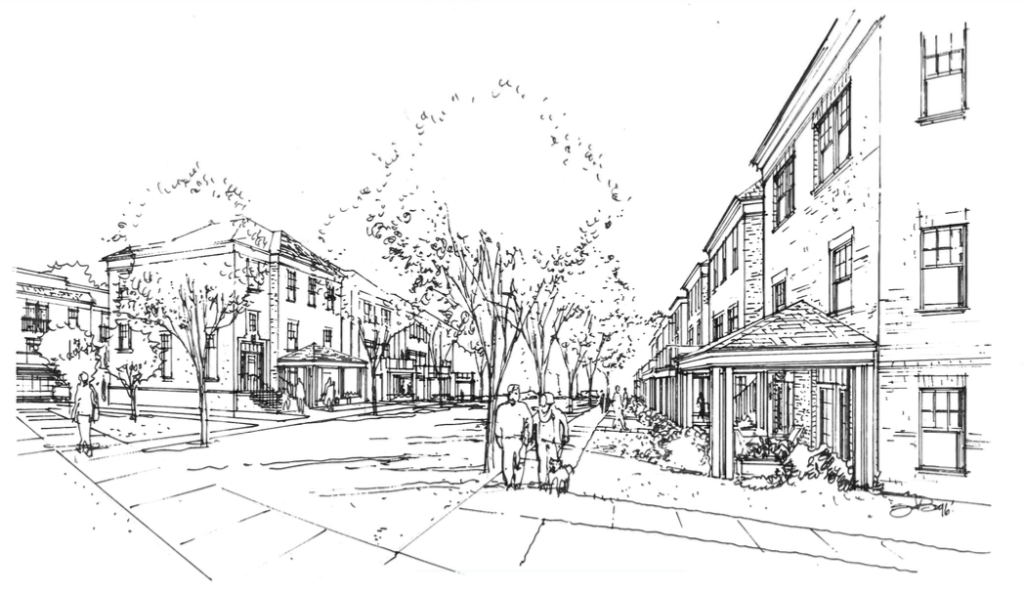Borough planners Clarke Caton Hintz previewed a quintet of mixed-use options for the 19-acre property last week.
By Matt Skoufalos
On Thursday, the borough planning board got its first look at initial concepts for the lot, as planner Phil Caton, of the Trenton-based Clarke Caton Hintz, walked its members through a variety of potential configurations for the space.
The information session represented the first step on the path to a formal redevelopment plan, which, once adopted, will allow the borough to proceed with its purchase of the land and the formal consummation of the deal.
Under the terms of its agreement with O’Neill, the borough has until June to make settlement, which sets up a pair of special government meetings along the way. The planning board will meet March 16 to review the redevelopment plan; the borough commissioners will meet April 4 to allow public discussion on an ordinance adopting the plan. Although that timeline is ambitious, a specific site plan for the property need not be in place for the redevelopment framework to be adopted, Caton said.
“Municipalities that have designated areas in need of redevelopment cannot access powers under the act until they adopt a redevelopment plan,” he said. “While there’s a very aggressive timeline to get a redevelopment plan adopted in order to let the borough access the bonding powers, the document itself can be fine-tuned, refined, and amended as time goes on.”
Having previously made a case for the Bancroft property being in need of redevelopment, Caton’s presentation Thursday focused on the residential and environmental objectives of the project, under which the borough plans to situate 70 market-rate, age-targeted townhomes and 10 affordable housing units. O’Neill submitted four design concepts for the layout of those units as well as street-level conceptual renderings of the townhouses themselves (click photos to enlarge).
The plan will incorporate green building techniques and sustainable design features as well as a significant allocation of “passive open space,” according to Caton’s report. That includes bike and walking paths that will connect to Hopkins Pond, Cooper River Park, and Kings Highway on the east side of Hopkins Lane, plus “an active recreation facility” on the west side, next to the high school.
The plan also calls for the preservation “and adaptive reuse” of the historic Lullworth Hall, its carriage house, “and any other historic resources on the property which can be reasonably preserved for beneficial use.” Other key design features include an emphasis on pedestrian and bike traffic over that of vehicles, minimization of impervious surface coverage, “innovative stormwater management control techniques,” and “the creative use of landscape material as an integral design element.”
“When you think about the Cooper River Park and corridor and Evans Pond and Hopkins Pond and its adjacency to the high school and its frontage to Kings Highway and its gateway to the borough, it is an extraordinary piece of property,” Caton said.
“The last use, the school, was there for over 100 years,” he said. “This will probably be there for over 100 years. For a village like Haddonfield, 19-acre sites don’t come up every day. It’s exciting. We all just want to make the absolute best we can of this opportunity.”
Order of operations
Haddonfield Mayor Jeffrey Kasko advised residents to consider the spirit of compromise before judging the proposed plans.
Balancing the competing demands attached to the site—environmental, residential, recreational—will require as much, especially as the municipal government must move quickly to hit its marks in the process.
“We’re trying to bring different groups and different viewpoints along so we don’t have an us-versus-them” situation, he said. “We’ve debated many different plans, we’ve had focus groups and polling and meetings. We need to conclude that debate now. We know what different options are, and we’re under the gun—because if we are to purchase that property, we have to do it by the end of June.”
Kasko described talks with O’Neill as being in “a quiet period,” but open and ongoing nonetheless.
“We have to do the redevelopment plan first and then designate,” the mayor said. “We do expect that he wants to develop something there, and he wants to work with the town on doing it.”
Haddonfield Commissioner John Moscatelli underscored Kasko’s perspective that the local government is doing its best to meet the terms of its agreement with O’Neill while following a prescribed public process. Once the deal is formalized, local authorities will have years to develop and approve a final site plan for the property, he said—but not if the agreement stalls.
“I think there are folks who think we’re going to see a fully engineered, fully designed, I–want-to-see-what-the-doorknobs-look-like plan, and that’s not going to happen,” Moscatelli said.
“We don’t own this property yet. If we don’t meet the terms of this agreement, then it can fall apart.
“We will literally have a couple of years before Bancroft leaves to adjust this plan,” he said. “We need to get enough detail on paper to qualify as a legal redevelopment plan to get this approved and execute our agreement with O’Neill.”
Townhomes v. Mid-rise
Initial reactions from the planning board were mixed, Moscatelli said. Some wondered whether 30-feet-wide townhomes would be too large to attract the 55-and-older buyers for whom the 70 market-rate units are intended.
“If we put in 70 market-rate townhouses that are going to attract families, we’re going to attract a lot of families with kids, and we don’t have that capacity in the schools,” Moscatelli said. “We’re concerned about that.”
An alternative, fifth plan proposed by Clarke Caton Hintz would scrap the townhouse model in favor of a pair of mid-rise apartment or condominium buildings with 100 units. Caton said that design would take advantage of the site topography so that the impact of the building footprint “would be screened by the berm on Kings Highway,” lessening the visual impact of a larger strucure.
“There’s about a 20-foot drop from Lullworth Hall to the part of the site where buildings are shown, so a five-story building really appears like a three-story building from the front of the site,” he said.
“If the target is an age-targeted market, these buildings allow living on one floor instead of two or three, which is a convenience to people as they get older, and it also allows for less site coverage and more open space.”
But Moscatelli pointed out that the agreement with O’Neill doesn’t cover such a plan, and could possibly require the project to be scaled up to two or three times its 100-unit inventory in order to be economically feasible.
“They haven’t gone through a full economic analysis to say this number of units would be viable,” he said. “A lot more would have to happen to make that work.”
Conversely, Kasko said that despite the vision of “nice, colonial brick townhomes that fit in with the town,” some residents have wondered whether the local real estate market will bear such an inventory, “depending on the size of them.
“I want to hear what different people have to say about that,” the mayor said.
Open-space plans could affect Hopkins Lane
In addition to the land allocation and the design and nature of the structures to be built on the site, the redevelopment could change the layout and traffic flow of Hopkins Lane, which connects Grove Street and Kings Highway along its edges. Moscatelli said that re-routing Hopkins Lane could allow for better open-space consolidation after Lullworth Hall is split off from the parcel.
“The idea of relocating it is an idea,” he said. “It may turn out to be infeasible. Just about anything we do residentially over there is going to improve traffic.”
“It’s certainly reasonable to think we might need to put sidewalks in [or that] the road might need to be widened.”
Moscatelli also cautioned that although preliminary plans for the open space adjacent to the high school indicate that it could be transformed into a baseball field or a parking lot, the costs of constructing either (or something else) are not included in the borough’s preliminary financial analysis, which only accounts for the cost of demolishing the existing Bancroft buildings there.
“We want the best solution on that site that we can, but we have gone around and around for the last decade on this,” he said. “In Haddonfield, a borough that’s 95% residential, we’ve decided to take this last large remaining piece of land and make it residential. It may not be the most exciting use or the most innovative use, but it’s adding more residential to a residential borough.
“Ultimately, we’re going to develop something there that’s going to cover the cost and not be a burden to the taxpayers,” Moscatelli said.
Number-crunching
The current assessed value of the land is $12.2 million, and O’Neill has agreed to sell it for $12.9 million. The deal includes a $600,000 opt-out clause that allows him to forfeit his rights as developer, bringing the theoretical maximum purchase price $13.5 million. If O’Neill elects to continue with the plan, he will buy back 8.2 acres at $5.5 million.
The borough will draw down its local Open Space Trust Fund by an estimated $1.2 million to offset the remaining purchase price; matching funds from the Camden County Open Space Preservation Trust Fund and state Green Acres dollars will add another $3.05 million. The sale of Lullworth Hall and the surrounding land is projected, conservatively, to contribute another $500,000 against another $1.9 million or so in demolition, soft costs, and bond issuance fees.
In the end, the borough is expected to bond slightly less than $5.1 million for the deal, which is estimated to incur new annual costs of some $380,000 for debt service alone. At an approximate value of $495,000 apiece for 70 market-rate townhomes and $120,000 for 10 affordable units, the development value of the site is estimated at $35.85 million, which should generate some $875,000 in new annual revenues, plus whatever new business is eventually situated in Lullworth Hall.
The net-positive difference figures to be about $500,000 annually, Moscatelli said. Even with a potential 20-year PILOT agreement in place, “you can cover a number of students and pick up quite a bit of trash with that,” he said.
“This isn’t some pie-in-the-sky, ‘they’ll never raise enough in tax money to cover those costs’” calculus, Moscatelli said. “You’ve got almost a half-million dollars of wiggle room.”

